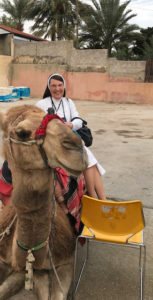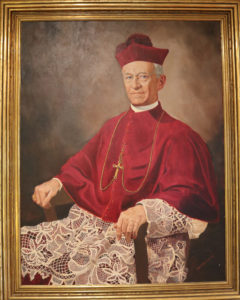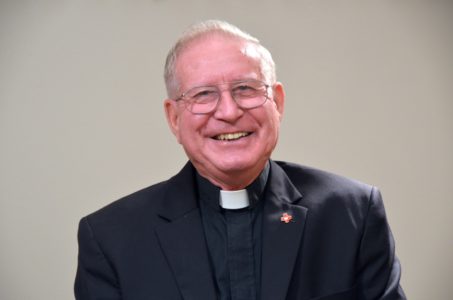
Sister Dorothea Sondgeroth took a turn riding a camel during her trip.
By Sister M. Dorothea Sondgeroth, O.P.
Lent 2018 has significant meaning for me as I began this holy season while on a pilgrimage to the Holy Land. I was privileged to be invited to join the Knights and Dames of the Holy Sepulcher who financially support the Holy Places in the Holy Land, especially the University of Bethlehem. The Equestrian Order of the Holy Sepulcher of Jerusalem is the only lay institution of the Vatican State charged with the task of providing for the needs of the activities and initiatives which are necessary to support the Christian presence in the Holy Land.
One of the Order’s principle goals is to sustain and aid the Catholic Church in the Holy Land. Without their membership as well as their support of and contributions to the upkeep of these sacred sites in the Holy Land, pilgrimages would not be possible for Christians, especially Catholics. The pilgrimage included the Shell Ceremony for the members of the Equestrian Order who have made a pilgrimage to the Holy Land.
The pilgrimage began as I joined up with Bishop Joseph Kopacz and 40 other friends departing from Newark for an overnight flight to Israel. Arriving in Tel Aviv, Israel’s center of culture, we set out on a life-changing journey in the footsteps of our Lord Jesus which offered a geography of our faith. The well versed tour guide made the scriptures come alive as we stopped at significant sites in the life of Jesus for the next ten days.
In Jaffa, the biblical port-town, stands St. Peter Church where the apostle had his vision which led to the first preaching of the gospel of Christ to the Gentiles. It was from here that Jonah set sail on his journey to Nineveh. We traveled on to the sparkling port city of Haifa and ascended Mount Carmel, home of the prophets Elijah and Elisha, to visit Stella Maris.
Each day offered opportunities for REFLECTION with the highlight of celebrating Eucharist with Bishop Kopacz as the main celebrant at holy places, first being at Mount Carmel in Haifa.
Continuing on to Cana of Galilee, where our Lord performed the first miracle of changing water into wine at the wedding feast, provided an occasion for the renewal of marriage vows by the pilgrim couples following a Eucharistic celebration. The pilgrimage took us to the city of Nazareth to visit the Basilica of the Annunciation, where the Angel Gabriel announced to the Virgin Mary that she would bear a child, and here Jesus spent his childhood with his parents, Joseph and Mary. Here marks the start of the Christian era. The drive to the summit of Mount Tabor offered time for scripture reading and a magnificent view of all the lower Galilee. Mt. Tabor is the “high mountain apart” which Jesus ascended with Peter, James and John and where He was transfigured before them.
Overlooking the Sea of Galilee, the Mount of Beatitudes provided a perfect setting for reflection time. There was found in the Sea of Galilee a wooden boat from the time of Jesus and people call it, the “Jesus Boat.” Following our excursion on the Sea of Galilee, we each received a certificate verifying that we sailed and prayed on a replica of the “Jesus Boat.”
On we traveled to Capernaum, home of Jesus during his ministry. Here Jesus met his first disciples, all fishermen who worked on the Sea of Galilee and where Jesus performed many miracles including the healing of Peter’s mother-in-law. After visiting the Synagogue and St. Peter’s house, the drive took us to the Church of the Primacy where Jesus appeared to the Apostles after His Resurrection and Tabgha, the site of the miracle of the multiplication of the loaves and the fishes. Leaving Galilee, our pilgrimage took us through the Judean wilderness to Jerusalem to the site on the Jordan River where we celebrated the RENEWAL of our Baptismal promises.
That day Eucharist was celebrated in the shepherds’ field offering more time for reflection and renewal. A visit to the Nativity Church in Bethlehem, the city of David, built by the Emperor Constantine in the fourth century over the traditional grotto of Jesus’ birth, the Manger, grotto of St. Jerome, the Church of St. Catherine and the Milk Grotto were inspiring sites giving pause for reflection and thanksgiving.
The creamy-white Church of the Milk Grotto is a Franciscan Chapel built over the cave in which the holy family sheltered during the flight to Egypt and where Mary nursed baby Jesus. The Via Dolorosa led to the Church of the Holy Sepulcher and there we visited Golgotha and Jesus’ tomb, a powerful and moving experience. A drive to the top of the Mount of Olives afforded a spectacular view of Jerusalem where we visited the Church of Pater Noster, Ascension and walked the Palm Sunday road to Dominus Flavit where Jesus wept over Jerusalem.
We proceeded to Gethsemani to visit the Church of All Nations and the Garden of Olives. A drive through the New City of Jerusalem to Ein Karem, the city of Judah, is associated with the life of St. John the Baptist. Here Zachariah, St. John’s father had his summer home and here the Virgin Mary visited her cousin, Elizabeth. The pilgrimage took us to the Visitation Church where Mary proclaimed her famous “Magnificat.”
From the Wailing Wall in the Old City of Jerusalem we saw a powerful view of the Dome of the Rock. The pilgrimage took us to Bethany to visit the site of the house of Mary, Martha and Lazarus and the tomb of Lazarus. There we celebrated the Eucharist with hearts filled with thanksgiving and praise to God for this pilgrimage. We continued through the Judean wilderness and along the Dead Sea to Qumran to see the caves where the Dead Sea Scrolls were discovered. A stop in Jericho, the oldest known city in the Western world, offered beautiful views of the rich valley with lush green plants, trees, fruits and camel rides.
This Holy Land pilgrimage was a powerful, moving experience immersing us in the Scriptures that offered time for REFLECTION on our faith, RENEWAL of our faith and REMEMBERING the privilege of having walked in the footsteps of Jesus, the source of our faith for which we can say, Praise God from Whom all blessings flow! Let us pray for the peace of Jerusalem.
(Sister Dorothea Sondgeroth, O.P., is the associate Executive director of St. Dominic Health Services Foundation.)


